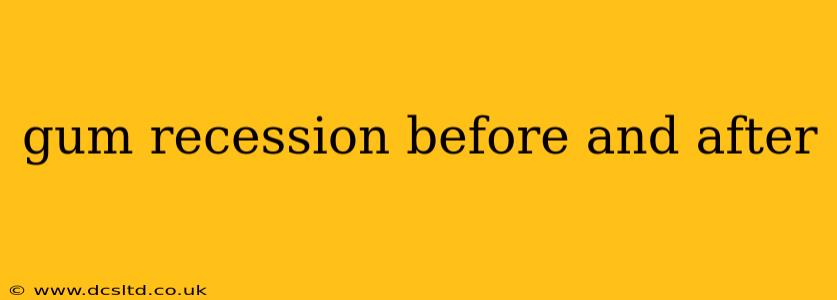Gum recession, the gradual pulling back of gum tissue from the teeth, is a prevalent dental issue affecting millions. It not only impacts the aesthetic appearance of your smile, but also exposes the roots of your teeth, making them vulnerable to sensitivity, decay, and even loss. This comprehensive guide explores the before-and-after aspects of gum recession, its causes, treatment options, and preventative measures.
What Does Gum Recession Look Like Before and After Treatment?
Before treatment, gum recession can manifest in various ways, depending on the severity. You might notice:
- Longer-appearing teeth: The teeth seem longer than usual because more of the root is visible.
- Notched gum line: The gum line may appear uneven or have noticeable indentations.
- Exposed tooth roots: This is a key indicator, making the root surface vulnerable.
- Sensitivity to hot and cold: Exposed dentin is highly sensitive to temperature changes.
- Changes in smile aesthetics: The overall appearance of your smile may be negatively affected.
After successful treatment, the improvements can be dramatic:
- Improved gum line: The gums will appear fuller and healthier, often restoring a more even gum line.
- Reduced sensitivity: The exposed roots are covered, significantly reducing or eliminating sensitivity.
- Enhanced smile aesthetics: Your smile will regain its natural beauty and confidence-boosting appearance.
- Protection of teeth: The roots are protected from further damage, decay, and potential loss.
The exact before-and-after results depend on the severity of the recession, the chosen treatment method, and your individual oral health.
What Causes Gum Recession?
Understanding the root causes is crucial for effective prevention and treatment. Here are some of the major contributing factors:
- Aggressive brushing: Brushing too hard with a hard-bristled toothbrush can damage gum tissue over time.
- Periodontal disease (gum disease): This is a leading cause, where inflammation destroys the supporting structures of the teeth.
- Genetics: Some individuals are genetically predisposed to gum recession.
- Teeth grinding (bruxism): Constant grinding or clenching can put excessive pressure on the gums.
- Misaligned bite (malocclusion): An improper bite can put uneven stress on the gums.
- Hormonal changes: Fluctuations in hormone levels can impact gum health.
- Smoking: Smoking weakens the immune system, making it harder to fight off gum infections.
- Certain medications: Some medications have side effects that can contribute to gum recession.
What are the Treatment Options for Gum Recession?
Several treatment options are available, ranging from minimally invasive procedures to more complex surgeries. The best approach depends on the severity and extent of the recession:
- Scaling and root planing: This deep cleaning procedure removes plaque and tartar from below the gum line to treat and control periodontal disease.
- Gum grafting: This surgical procedure involves taking gum tissue from another area of the mouth (or using a synthetic graft) and attaching it to the affected area to cover the exposed roots. Different types of gum grafts exist, including free gingival grafts, connective tissue grafts, and pedicle grafts.
- Pinhole surgical technique: This minimally invasive procedure uses specialized instruments to reposition the gum tissue without the need for sutures or incisions.
- Enamel Matrix Derivative (EMD) gel: This gel is used to promote the regeneration of gum tissue and is often used in conjunction with other procedures.
How Can I Prevent Gum Recession?
Prevention is key to maintaining healthy gums and preventing recession. Here are some essential preventative measures:
- Gentle brushing: Use a soft-bristled toothbrush and brush gently in circular motions.
- Proper flossing: Flossing daily helps remove plaque and food particles from between the teeth and under the gum line.
- Regular dental checkups: Schedule regular professional cleanings and checkups to detect and address gum problems early.
- Manage stress: Stress can exacerbate periodontal disease.
- Quit smoking: Smoking significantly increases the risk of gum disease and recession.
- Address bruxism: Use a mouthguard if you grind or clench your teeth.
Is Gum Recession Painful?
Gum recession itself isn't typically painful in the early stages. However, as it progresses and exposes the tooth roots, sensitivity to hot, cold, and sweet substances is common. Advanced recession can also lead to pain and discomfort associated with tooth decay or gum infection.
Can Gum Recession Be Reversed?
While completely reversing severe gum recession might not always be possible, treatment can significantly improve the condition, cover exposed roots, and prevent further recession. Early intervention is crucial for the most successful outcome.
How Much Does Gum Recession Treatment Cost?
The cost of gum recession treatment varies considerably depending on the extent of the recession, the treatment method chosen, and your location. It's best to consult with your dentist or periodontist for a personalized cost estimate.
By understanding the causes, treatment options, and preventative measures associated with gum recession, you can take proactive steps to protect your oral health and maintain a healthy, beautiful smile. Remember to consult a dentist or periodontist for diagnosis and treatment recommendations.
